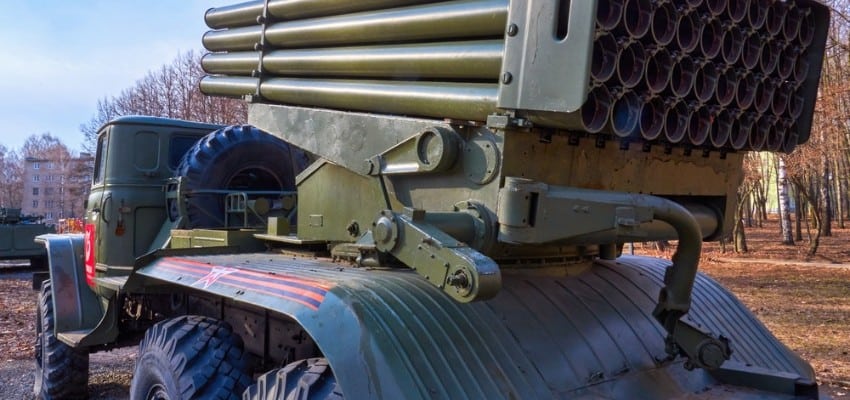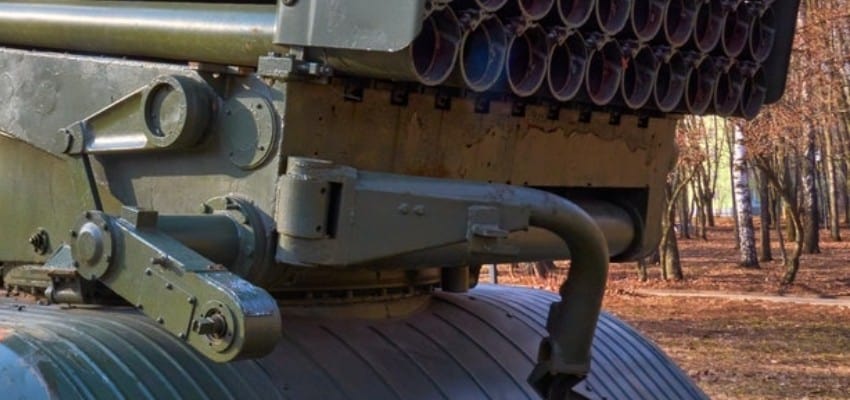|
|
Content Assessment: Hollow Shells? Ukraine Conflict Assessments in Maps (June 8 – 12, 2022)
Information - 93%
Insight - 94%
Relevance - 92%
Objectivity - 95%
Authority - 96%
94%
Excellent
A short percentage-based assessment of the qualitative benefit of the post highlighting the recent Ukraine conflict assessments in maps from the Institute for the Study of War.
Editor’s Note: One of the most accurate and detailed sources for ongoing updates on the Ukraine crisis is the Ukraine Conflict Update from the Institute for the Study of War. The Institute for the Study of War (ISW) is a 501(c)(3) organization and produces strictly non-partisan, non-ideological, fact-based research. ISW seeks to promote an informed understanding of war and military affairs through comprehensive, independent, and accessible open-source research and analysis. ISW’s research is made available to the general public, military practitioners, policymakers, and media members. Providing a daily synthesis of key events related to the Russian aggression against Ukraine, ISW updates may benefit cybersecurity, information governance, and legal discovery professionals as they follow the business, information technology, and legal trends and trajectories impacted by and stemming from the current Ukraine conflict.
Assessment and Maps*
Ukraine Conflict Assessments – An Overview in Maps
- Institute for the Study of War (ISW), Russia Team
- Critical Threats Project (CTP), American Enterprise Institute
General Assessment Background Info
- ISW systematically publishes Russian campaign assessments that include maps highlighting the assessed control of terrain in Ukraine and main Russian maneuver axes.
- These maps augment daily synthetic products that cover key events related to renewed Russian aggression against Ukraine.
The Russian Offensive Campaign Assessments
- June 12, 2022
- By Karolina Hird, Frederick W. Kagan, George Barros, and Grace Mappes
Russian forces continue to struggle with generating additional combat-capable units. The UK Ministry of Defense reported on June 12 that Russian forces have been trying to produce more combat units by preparing to deploy third battalion tactical groups (BTGs) from some units over the last few weeks. The UK MoD noted that Russian brigades and regiments normally can generate two BTGs, but doing so leaves the parent units largely hollow shells. The UK MOD concluded that these third BTGs will likely be understaffed and rely on recruits and mobilized reservists. Their deployment will likely adversely impact the capacity of their parent units to regenerate their combat power for quite some time. BTGs generated in this fashion will not have the combat power of regular BTGs. It will be important not to overestimate Russian reserves produced in this way by counting these third BTGs as if they were normal BTGs.
Pro-Russian sources are continuing to spread disinformation to sow anxiety and resentment among the Ukrainian population. Russian Telegram channels reportedly began spreading a fake mobilization order on June 12 that they falsely attributed to the Ukrainian General Staff. The fake order called for the mobilization of all eligible Ukrainian women to report for duty by “June 31” (sic).
Key Takeaways
- Russian forces continued ground assaults in Severodonetsk and blew up bridges that connect Severodonetsk to Lysychansk across the Siverskyi Donets River in a likely attempt to cut Ukrainian ground lines of communication (GLOCs) that run from Bakhmut to Lysychansk and Severodonetsk.
- Russian forces made incremental gains to the southeast of Izyum and will likely continue attempts to advance on Slovyansk from the northwest.
- Russian forces continued efforts to push Ukrainian troops back from contested frontlines northeast of Kharkiv City.
- Russian forces focused on maintaining defensive lines along the Southern Axis.
- June 11, 2022
- By Kateryna Stepanenko, Mason Clark, and George Barros
Ukrainian intelligence assesses that the Russian military is extending its planning to fight a longer war, though Russian force generation and reserves likely remain poor. Deputy Head of the Ukrainian Main Intelligence Directorate (GUR) Vadym Skibitsky stated the GUR received confirmed information that Russian forces have extended their war planning for the next 120 days, extending to October 2022. Skibitsky said that Russian forces will adjust the plan depending on their successes in Donbas and noted that the Russian General Staff is modifying their invasion plans almost every month. Skibitsky’s statement likely indicates the Kremlin has, at a minimum, acknowledged it cannot achieve its objectives in Ukraine quickly and is further adjusting its military objectives in an attempt to correct the initial deficiencies in the invasion of Ukraine. Skibitsky also claimed that Russian forces have an additional 40 battalion tactical groups (BTGs) in reserve, after having already deployed 103 BTGs to Ukraine. This report is highly unlikely to mean Russian forces retain 40 full-strength and effective BTGs in Russia. At most, these “BTGs” are likely small collections of personnel cobbled together from other units. The Russian military is additionally unlikely to be holding such a significant portion of its force in reserve due to continuing manpower shortages in existing frontline units.
Ukrainian officials continued to increase their requests for Western offensive and defensive equipment, particularly regarding capabilities necessary to combat Russian artillery superiority. Head of the Ukrainian Northern Operational Command Dmytro Krasilnikov reported that Ukrainian forces are experiencing a shortage in long-range artillery systems, while Russian artillery continues to overpower Ukrainian infantry. Ukrainian Advisor to Cabinet of Ministers Oleksandr Danylyuk stated that Russian forces adopted a new unspecified strategy that allows them to make more careful maneuvers. Danylyuk added that Russian forces have more resources than Ukraine, which would prove advantageous in a protracted conflict. Severodonetsk Mayor Oleksandr Stryuk said that Ukrainian defenders need long-range artillery and air defense systems to strike against advancing Russian troops in Luhansk Oblast. Ukrainian forces will need consistent Western support, particularly regarding artillery systems, as Russian numbers and resources take their toll on Ukrainian forces in increasingly positional warfare.
Key Takeaways
- Russian forces continued to conduct ground offensives within the Severodonetsk area, but Ukrainian defenders retain control of the industrial area of the city as of June 11.
- Russian forces likely resumed efforts to cut the T1303 Hirske-Lysyschansk highway and launched failed assaults on settlements along the T1302 Bakhmut-Lysychank highway.
- Russian forces continued assaults on settlements southwest and southeast of Izyum in an effort to resume drives on Slovyansk.
- Ukrainian forces likely resumed counteroffensives northwest of Kherson City on June 11, south of their previous operations.
- Russian occupation officials distributed the first batch of Russian passports in Kherson City and Melitopol.
- June 10, 2022
- By Karolina Hird, Kateryna Stepanenko, and Mason Clark
Ukrainian officials are increasing the urgency of their requests for more-sophisticated Western-provided weapons systems amid reports of growing Russian artillery superiority. Several Western media outlets reported in the last 48 hours that Ukrainian military and government officials are increasingly highlighting the fact that Ukrainian troops are trapped in an “artillery war” on critical frontlines and are at a distinct disadvantage in terms of artillery systems. Deputy Head of the Ukrainian Main Intelligence Directorate (GUR) Vadym Skibitsky stated that Russian troops possess 10 to 15 artillery pieces to every one Ukrainian artillery piece and that Ukrainian forces have almost completely exhausted their artillery ammunition. Considering the current prevalence of protracted positional battles, especially in the Severodonetsk-Lysychansk area, Ukrainian forces urgently need fresh supplies of artillery systems. As Ukrainian forces use the last of their stocks of Soviet-era weapon systems and munitions, they will require consistent Western support to transition to new supply chains of ammunition and key artillery systems. Effective artillery will be increasingly decisive in the largely static fighting in eastern Ukraine.
Russian military authorities continue to struggle with force generation and are facing the consequences of aggressive forced mobilization efforts. Ukraine’s Security Service (SBU) claimed they captured a new group of Russian prisoners of war who reportedly were recruited through a private military company and told they were going to be providing security services but were instead sent to the frontline in Luhansk. The Ukrainian General Staff similarly reported that units comprised of forcibly mobilized personnel are refusing to participate in combat in the Donbas due to high losses. The Ukrainian Main Intelligence Directorate (GUR) cited intercepted phone calls and claimed that Russian soldiers are refusing to fight and are being threatened with prosecution—despite their lack of equipment and weapons within their units. Such reports are consistent with previous reports that Russian forced mobilization efforts are self-destructive and may result in mounting discontent and declining morale and discipline.
Key Takeaways
- Ukrainian officials are increasing the urgency of their requests for Western weapons systems due to Russia’s artillery superiority.
- Russian forces are continuing ground assaults within Severodonetsk but have yet to secure full control of the city as of June 10.
- Russian forces are preparing to renew offensive operations toward Slovyansk and made minor gains to the north of the city.
- Russian forces are continuing efforts to cut the T1302 Bakhmut-Lysychansk highway and conducting assaults on settlements near the highway.
- Russian troops reportedly took control of the Kinburn Spit in the northern Black Sea, which will allow them to exert further control of the Black Sea coast.
- June 9, 2022
- Karolina Hird, Kateryna Stepanenko, and Mason Clar
Russian forces are continuing to deploy outdated military equipment to Ukraine to replace losses. The Ukrainian Main Intelligence Directorate (GUR) reported on June 9 that Russian forces are mining Kherson Oblast with mines from the 1950s to defend against recent Ukrainian counterattacks in northwestern Kherson Oblast. The GUR stated that Russian forces moved these mines from Russia’s Rostov Oblast to the Kherson area despite the fact the mines were meant to be destroyed. The GUR claimed that some of the mines detonated during the transportation processes and killed Russian sappers from the 49th Combined Arms Army. The GUR’s report is consistent with previous statements that Russian forces are moving old and obsolete equipment to Ukraine to make up for equipment losses, including deploying T-62 tanks to the Melitopol area and pulling MLRS and 152mm howitzers from storage in Irkutsk, Siberia.
Russian military command continues to face pervasive issues with force generation. The Ukrainian Resistance Center reported that Russian officials in Luhansk Oblast have had to reduce their mobilization efforts due to widespread protests against aggressive mobilization efforts that have taken a toll on the labor market in Luhansk. Attacks on Russian military recruitment offices are additionally continuing. An unidentified assailant threw a Molotov cocktail at the military commissariat in Vladivostok, which is the eighteenth such reported attack on Russian territory since the beginning of the war. As Russian officials escalate mobilization efforts over the background of continued losses in Ukraine, they will continue to run the risk of instigating public dissent and pushback against such recruitment practices.
Key Takeaways
- Russian officials are increasingly taking over governmental positions in occupied Ukrainian territory, advancing the Kremlin’s likely efforts to annex occupied areas of Ukraine into Russia as an okrug (federal district).
- Russian forces continued to fight for the Azot industrial zone in Severodonetsk under the cover of heavy artillery fire.
- Russian forces made marginal gains north of Slovyansk but are likely to face difficulties assaulting the city itself because of the tactical challenges posed by crossing the Siverskyi Donets River.
- Russian forces made incremental advances to the east of Bakhmut and will continue efforts to cut Ukrainian lines of communication to the northeast of Bakhmut.
- Russian forces are likely engaged in limited fighting along occupied frontiers in northern Kharkiv Oblast.
- Russian forces continue to focus on strengthening defensive lines along the Southern Axis and are intensifying ground attacks in northeastern Zaporizhia Oblast with the support of troop and equipment rotations.
- June 8, 2022
- By Kateryna Stepanenko, Karolina Hird, Mason Clark, and George Barros
Russian forces are escalating the use of psychological and information operations to damage the morale of Ukrainian soldiers. The Ukrainian Main Intelligence Directorate (GUR) reported on June 8 that Russian forces are sending threatening messages to the personal devices of Ukrainian servicemen calling on them to betray their service oaths, lay down their arms, surrender, or defect to Russia. The GUR reported that Russian forces are sending messages on a variety of platforms including SMS, Telegram, Viber, Signal, and WhatsApp and that the messages use location information to threaten to harm Ukrainian soldiers or their family members. Ukrainian military expert Dmytro Snegirov additionally noted that Russian propagandists are conducting informational and psychological campaigns to spoil the morale of Ukrainian troops by disseminating information that the battle for Severodonetsk will become the “next Mariupol.” These information and psychological attacks likely seek to lower the morale of Ukrainian servicemen as operations on multiple axes of advance continue to generate high causalities on both the Ukrainian and Russian sides.
Russian military commanders continue to face force generation challenges. The Ukrainian Southern Operational Command reported that Russian military enlistment offices in Crimea are falsifying the results of mandatory medical exams administered during the summer conscription period to maximize the number of recruits. Russian police also arrested a man who threw a molotov cocktail and set fire to a local Crimean administration building in protest of the Russian invasion of Ukraine, likely indicating growing discontent with Russian war efforts in Crimea. ISW has previously reported that forced mobilization in the Donetsk and Luhansk People’s Republics (DNR and LNR) is exacerbating social tensions and sparking protests in Donbas. The Ukrainian General Staff also reported that unspecified elements of the 106th and 76th Guards Airborne Assault Divisions refused to participate in combat in Luhansk Oblast and returned to Russia. The 76th Guards Airborne Assault Division previously participated in assaults on Kyiv, Izyum, and Popasna, which has likely led to the demoralization of troops.
Key Takeaways
- Russian forces continued assaults against Ukrainian positions in Severodonetsk. Russian forces simultaneously seek to outflank Ukrainian positions in the region to avoid the necessity of making an opposed crossing of the Siversky Donets river.
- Russian forces are continuing operations around Sviatohirsk and west of Lyman to link up with operations southeast of Izyum and drive on Slovyansk.
- Russian forces are intensifying their operations in northwestern Kherson Oblast in response to recent Ukrainian counterattacks.
- Russian forces in Zaporizhia Oblast are focusing ground and artillery attacks near the Zaporizhia-Donetsk Oblast border and likely are seeking to strengthen control of the highway between Vasylivka-Orikhiv and Huliapole to support operations in northeast Zaporizhia.
- Russian-backed occupation authorities are attempting to set conditions for the political integration of occupied areas into the Russian Federation but are likely acting independently and in an incoherent manner due to the lack of a unifying occupation authority.
- Russian forces intensified psychological and information operations to degrade Ukrainian morale.
We do not report in detail on Russian war crimes because those activities are well-covered in Western media and do not directly affect the military operations we are assessing and forecasting. We will continue to evaluate and report on the effects of these criminal activities on the Ukrainian military and population and specifically on combat in Ukrainian urban areas. We utterly condemn these Russian violations of the laws of armed conflict, Geneva Conventions, and humanity even though we do not describe them in these reports.
Chronology of Maps from June 8-12 2022 – Mouseover to Scroll
Ukraine Conflict Maps - 070822-071222See the Institute for the Study of War Interactive Map of the Russian Invasion
Read the latest Ukraine Conflict updates from the Institute for the Study of War
* Shared with direct express permission from the Institute for the Study of War (ISW).
About the Institute for the Study of War Research Methodology
ISW’s research methodology relies on both primary and secondary sources, enabling researchers to develop a comprehensive understanding of the situation on the ground. In order to analyze military and political developments in any given area, ISW’s research analysts must wholly understand the systems of enemy and friendly forces. They must also understand the population demographics, physical terrain, politics, and history of that area. This lays the analytical foundation for understanding the reasons for particular developments and fulfilling their assigned research objectives. ISW analysts also spend time in places like Iraq, Afghanistan, and elsewhere in order to gain a better understanding of the security and political situation and to evaluate the implementation of current strategies and policies. Our researchers compile data and analyze trends, producing a granular analysis of developments in areas of research, producing an accurate, high-resolution, timely, and thorough picture of the situation. ISW’s research methodology guarantees its success and commitment to improving the nation’s ability to execute military operations, achieve strategic objectives, and respond to emerging problems that may require the use of American military power.
About the Institute for the Study of War
The Institute for the Study of War advances an informed understanding of military affairs through reliable research, trusted analysis, and innovative education. We are committed to improving the nation’s ability to execute military operations and respond to emerging threats in order to achieve U.S. strategic objectives. ISW is a non-partisan, non-profit, public policy research organization.
Learn more, get involved, and contribute today.
Additional Reading
- [Annual Update] International Cyber Law in Practice: Interactive Toolkit
- Data Embassies: Sovereignty, Security, and Continuity for Nation-States
Source: ComplexDiscovery


























